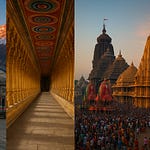📜 The Mythical Genesis – Where the Moon Loved a Mortal
The origins of Khajuraho are not just rooted in stone and soil but in celestial romance and mystical lore. According to legend, a beautiful Brahmin woman named Hemavati, while bathing in a forest pool under a full moon, was seduced by Chandra, the Moon God. From this divine union was born a son—Chandravarman.
Hemavati, fearing dishonor, raised him in the forest, instilling in him virtues of leadership and devotion. As he matured, Chandravarman founded the Chandela dynasty around the 9th century CE and built temples to honor his mother’s wish—to immortalize human passions, divine spirituality, and the essence of life in stone.
Thus was born Khajuraho—a city that, for two centuries, became a canvas for the grand philosophical and artistic flowering of India.
🧭 Geography, Symbolism, and Sacred Layout
Located in the Chhatarpur district of Madhya Pradesh, the Khajuraho temples sit in a triangular configuration. This layout isn’t random—it mirrors the Tantric mandala, representing the cosmic order and human ascent from the earthly realm to the spiritual.
The western group faces the rising sun – symbolic of illumination
The temples align with the cardinal directions – emphasizing universal harmony
Water bodies nearby, now partially dried, once represented the sacred yoni (womb), complementing the temple spires (lingas)
The name Khajuraho derives from “Khajur” (date palm trees) and “vahaka” (bearer)—a reference to the dense groves that once surrounded these spiritual havens.
🏛️ The Chandela Era – Patronage of Gods and Masons
The Chandela rulers, particularly Yashovarman, Dhanga, Vidyadhara, and Ganda, were devout Shaivites and Vaishnavites, yet their vision was deeply pluralistic. Between 950 CE and 1050 CE, they built nearly 85 temples dedicated to Shiva, Vishnu, the Jain Tirthankaras, and Shakti. Today, about 22 survive.
Unlike many dynasties that focused on fortresses and politics, the Chandelas gave the world architecture with soul, where stone danced, sang, and meditated.
🧱 Architectural Brilliance – The Nagara Style at Its Zenith
The temples follow the Nagara school of North Indian temple architecture:
Elevated plinth (jagati): Allows circumambulation (pradakshina)
Mandapa (pillared halls): For devotional rituals and gatherings
Garbhagriha (sanctum sanctorum): Where the deity resides
Shikhara (spire): Soars above the garbhagriha, symbolizing Mount Meru, the cosmic mountain
The Sculptural Orchestra:
The entire temple is covered with tiers of sculptures that narrate epics, whisper desires, and awaken divine insight. These include:
Erotic couples (Mithuna): Union of Shiva-Shakti, representing creative energy
Musicians and dancers: Celebrating joy and devotion
Warriors, yogis, acrobats, mythical beasts: Expressing the rhythm of life
🎨 The Erotic Imagery – Sacred, Not Scandalous
Popular narratives often reduce Khajuraho to its erotic sculptures, but that is a gross oversimplification.
Only about 10% of carvings depict sensuality, and these are deliberately placed on the outer walls—symbolizing that one must pass through desire and illusion (Maya) before reaching the inner sanctum of purity.
In the Tantric worldview:
Kama (desire) is not a sin—it is a legitimate path to moksha (liberation).
These carvings represent the cosmic union—not vulgarity but metaphysical love.
Their placement—at thresholds, corners, and transitional spaces—is intentional. They serve as guardians of sacred thresholds, and reminders that life, in all its forms, is divine.
🛕 Iconic Temples of Khajuraho – Pillars of Devotion
1. Kandariya Mahadev Temple
Dedicated to Lord Shiva
Tallest temple (approx. 31m high)
Houses an exquisitely carved Shiva linga
Sculptures: Over 800 on outer walls, including devatas, mithuna couples, and celestial beings
2. Lakshmana Temple
Earliest surviving temple (built by Yashovarman)
Dedicated to Vaikuntha Vishnu (with three faces)
Elaborate narrative friezes of Ramayana, Mahabharata, and Vishnu Purana
3. Vishvanatha Temple
Worships Lord Shiva
Includes carvings of surahsundaris (divine maidens) and erotic figures in harmony
4. Parsvanath Jain Temple
Largest Jain temple at Khajuraho
Celebrates Tirthankara Parsvanath, decorated with female forms and mythical beings
5. Chaturbhuj Temple
Only temple without any erotic sculpture
Dedicated to Vishnu with four arms
🔱 Rituals, Aarti, and Living Devotion
While most temples today are archaeological relics, some are still active places of worship.
Daily Rituals (at active temples like Matangeshwar):
Morning and Evening Aarti: With bells, conch-shells, and incense
Offerings: Milk, bilva leaves, rudraksha, and vermillion
Devotees chant Shiva Stotrams, Vishnu Sahasranama, and Bhajans
Festivals Celebrated:
Maha Shivaratri: Thousands gather at Matangeshwar Temple to perform night-long vigil and Rudra-Abhishek
Navratri: Celebrations of Shakti with devotional songs and dance
Khajuraho Dance Festival (February): A fusion of Bharatanatyam, Kathak, Odissi, and more, performed against the spiritual backdrop of illuminated temples
🌌 CSymbolism, Tantra, and Kundalini
The temples are not just monuments—they are living mandalas.
Erotic sculptures: Represent awakening of kundalini, the coiled serpent at the base of the spine
Ascending spires: Symbolize the journey of energy through chakras
Garbha-griha: Represents the bindu—the still point of meditation
Every Khajuraho temple is a spiritual machine—architecturally precise and energetically potent, designed to elevate the mind from lust to liberation.
🧘♂️Experience for the Devotee
Khajuraho is more than just sightseeing—it’s a soulful immersion.
Pilgrims bathe in the Shiv Sagar tank
Meditate at sunrise as the first rays hit the shikharas
Chant mantras in quiet corridors where echoes feel divine
Participate in guided spiritual walks that explain symbolism beyond sculpture
Foreign seekers often describe the experience as "awakening the third eye", such is the psychic power embedded in its symmetry and iconography.
🧳 Travel Guide – Sacred Sojourn
Best Time to Visit:
October to March: Cool weather and festive season
February: For the Khajuraho Dance Festival
How to Reach:
Air: Khajuraho Airport (flights from Delhi, Varanasi)
Train: Khajuraho Railway Station (connects with Jhansi and Satna)
Road: Smooth connectivity from Bhopal, Jhansi, Gwalior
Where to Stay:
Luxury: The Lalit Temple View, Radisson Jass
Budget: Zostel Khajuraho, Hotel Zen
Many resorts offer yoga retreats, spiritual walks, and guided temple experiences
🪔 Restoration, Legacy, and UNESCO Status
The temples were lost to the jungle for centuries after Muslim invasions, rediscovered only in 1838 by British surveyor T.S. Burt. Since then:
UNESCO Heritage Status granted in 1986
Managed by Archaeological Survey of India
Restoration efforts ongoing, yet some remain in ruin—like whispers of time
Khajuraho is often referenced in global academic circles as the apex of Indian temple architecture, where form meets philosophy, and desire meets divinity.
🧡 Khajuraho – India’s Spiritual Poem in Stone
To the untrained eye, Khajuraho is about eroticism. But to the seeker, the devotee, and the historian—it is a multi-layered treatise on life, death, desire, duty, liberation, and the cosmic union of opposites.
It teaches:
That Kama and Moksha are not contradictions
That art can be divine without being prudish
That architecture can transmit spirituality
In a world that increasingly disconnects the spiritual from the sensual, Khajuraho stands tall—a monument of truth, where everything is sacred, and nothing is shameful.
"These stones do not merely sit—they speak. And if you listen closely, they will whisper to you the secrets of the cosmos."










